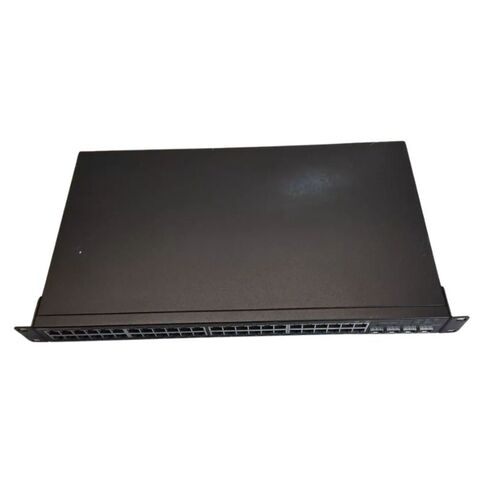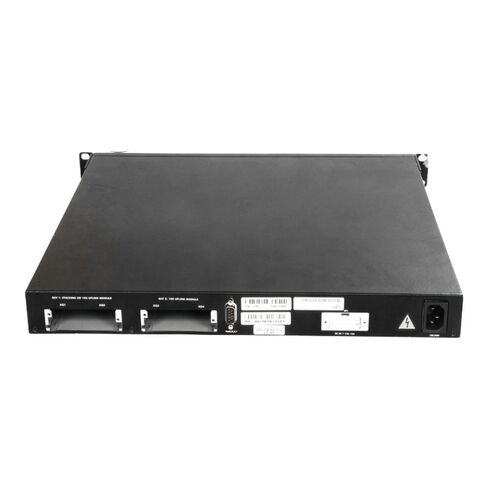222-6714 Dell PowerConnect Ethernet Switches 48-Port Stackable Network
- — Free Ground Shipping
- — Min. 6-month Replacement Warranty
- — Genuine/Authentic Products
- — Easy Return and Exchange
- — Different Payment Methods
- — Best Price
- — We Guarantee Price Matching
- — Tax-Exempt Facilities
- — 24/7 Live Chat, Phone Support
- — Visa, MasterCard, Discover, and Amex
- — JCB, Diners Club, UnionPay
- — PayPal, ACH/Bank Transfer (11% Off)
- — Apple Pay, Amazon Pay, Google Pay
- — Buy Now, Pay Later - Affirm, Afterpay
- — GOV/EDU/Institutions PO's Accepted
- — Invoices
- — Deliver Anywhere
- — Express Delivery in the USA and Worldwide
- — Ship to -APO -FPO
- — For USA - Free Ground Shipping
- — Worldwide - from $30
Key Specifications of the Dell 48-Port Stackable Switch
This Dell 48-port switch 222-6714 is designed for high performance and scalability in enterprise environments, ensuring robust networking capabilities for a variety of devices.
Overview of the Device
- Product Type: 48-Port Switch
- Model Number: 222-6714
- Manufacturer: Dell
Device Features
- Device Type: Stackable Switch with 48 Ports
- Enclosure Type: Desktop – 1U form factor
- Port Configuration: 48 x 10/100/1000 Mbps + 4 x Shared SFP ports
- Mac Address Table: Supports up to 16,000 entries
Connectivity & Interface Details
- Interfaces: 48 x Gigabit Ethernet (1000Base-T) via RJ-45 ports
- SFP Ports: 4 x Mini-GBIC (Small Form-factor Pluggable)
Advanced Network Features
- Auto-Uplink: Automatic MDI/MDI-X detection and adjustment
- Port Mirroring: Facilitates real-time monitoring of network traffic
- Queuing Mechanisms: Weighted Round Robin (WRR) Queuing for efficient data handling
- IPv6 Support: Full compatibility for next-generation network protocols
- Access Control Lists (ACL): Enables granular control over network traffic
- Quality of Service (QoS): Ensures priority handling for critical applications
Compliance with Networking Standards
- IEEE 802.2, IEEE 802.3, IEEE 802.3u, IEEE 802.3i, IEEE 802.3z, IEEE 802.1d, IEEE 802.1q
- IEEE 802.3ab, IEEE 802.1p, IEEE 802.3x, IEEE 802.3ad (LACP), IEEE 802.1w, IEEE 802.1x
- IEEE 802.3ae, IEEE 802.3ac, IEEE 802.3ak, IEEE 802.1ab (LLDP)
Memory and Storage
- Flash Memory: 32 MB
Port Number
Overview
Dell PowerConnect Ethernet Switches are renowned for their exceptional performance and reliability. One of the key features that sets these switches apart from the competition is their impressive port number, with a staggering 48 ports. This abundance of ports makes these switches ideal for organizations of all sizes, from small businesses to large enterprises.
Benefits of 48 Ports
Scalability
Having 48 ports on a Dell PowerConnect Ethernet Switch provides users with unmatched scalability. This allows businesses to easily expand their network without the need for additional switches, reducing costs and simplifying network management. With more ports available, organizations can effortlessly connect multiple devices, such as computers, servers, printers, and IP phones, to their network infrastructure.
Flexibility
The 48-port configuration offers unmatched flexibility in network design. Users can create multiple VLANs (Virtual Local Area Networks) to segment their network, enhancing security and improving overall performance. Additionally, having a large number of ports allows for more efficient cable management, reducing clutter and ensuring a clean and organized network setup.
High Bandwidth
With 48 ports on a Dell PowerConnect Ethernet Switch, users can enjoy high-speed connectivity across their entire network. This is particularly important for data-intensive activities such as video streaming, file sharing, and VoIP (Voice over Internet Protocol) calls. The ample number of ports ensures that every device connected to the switch can benefit from fast and reliable data transmission.
Importance of 48 Ports
Meeting Current and Future Needs
In today's digital age, businesses rely heavily on technology to operate efficiently. Having a switch with 48 ports ensures that organizations can meet their current networking requirements while also being well-equipped to handle future growth. This future-proofing capability is crucial, as it eliminates the need for frequent network infrastructure upgrades.
Enhanced Productivity
The 48-port configuration allows businesses to maximize productivity by connecting multiple devices simultaneously. Employees can seamlessly access shared resources, collaborate on projects, and communicate with colleagues without experiencing any network bottlenecks. This improved connectivity ultimately leads to increased efficiency and reduced downtime.
Cost-Effective Solution
Investing in a Dell PowerConnect Ethernet Switch with 48 ports proves to be a cost-effective solution in the long run. Organizations can consolidate their network infrastructure, eliminating the need for multiple switches and reducing maintenance and management costs. The high port count also prevents the need for costly network upgrades in the near future, saving both time and money.
Stackable
Overview
Another notable feature of Dell PowerConnect Ethernet Switches is their stackable capability. With a stackable factor of 1, these switches can be easily interconnected to create a unified and highly efficient network infrastructure.
Benefits of Stackable Switches
Improved Network Performance
By stacking multiple switches together, organizations can create a single logical unit with increased bandwidth and improved performance. This allows for seamless communication between devices connected to different switches within the stack, eliminating bottlenecks and enhancing overall network efficiency.
Simplified Network Management
Stackable switches offer centralized management, allowing network administrators to configure and monitor the entire network stack from a single interface. This eliminates the need to individually manage each switch, saving valuable time and streamlining network administration tasks. Additionally, firmware updates and configuration changes can be applied simultaneously across all switches within the stack, ensuring consistency and reducing human errors.
Redundancy and High Availability
Stacking switches provides redundancy and high availability, minimizing the risk of network failures. If one switch within the stack fails, the remaining switches automatically take over, ensuring uninterrupted network connectivity. This redundancy feature is particularly important for critical business applications and services that require continuous uptime.
Importance of Stackable Switches
Scalability and Future Growth
The stackable feature allows organizations to easily expand their network as their needs evolve. By adding more switches to the stack, businesses can effortlessly increase their port count and overall network capacity. This scalability ensures that the network infrastructure can accommodate future growth without requiring significant investments or complex network redesigns.
Enhanced Network Resilience
Stackable switches provide improved network resilience through features like link aggregation and rapid spanning tree protocol (RSTP). Link aggregation allows multiple physical connections between switches to be combined into a single logical link, increasing both bandwidth and redundancy. RSTP ensures rapid convergence in case of link failures, minimizing downtime and maintaining network stability.
Cost-Efficient Solution
Opting for stackable switches offers cost savings by reducing the need for additional equipment and simplifying network management. Instead of purchasing multiple standalone switches, organizations can invest in a stackable switch solution that meets their current requirements while allowing for future expansion. The streamlined management also reduces operational costs, as it requires fewer resources and minimizes the risk of configuration errors.
Network Type
Overview
Dell PowerConnect Ethernet Switches support various network types, with a primary focus on Ethernet-based networks. These switches are designed to provide reliable connectivity and optimal performance in a wide range of network environments.
Benefits of Network Type Support
Versatility
Supporting multiple network types allows Dell PowerConnect Ethernet Switches to be deployed in diverse environments, catering to the unique requirements of different industries and organizations. Whether it's a small office network, a data center, or an enterprise campus, these switches can seamlessly integrate and deliver consistent performance across various network architectures.
Interoperability
By supporting Ethernet-based networks, these switches ensure interoperability with a wide range of devices and network equipment. Ethernet has become the de facto standard for networking, making it compatible with virtually all modern devices and facilitating easy integration with existing infrastructure. This interoperability enhances flexibility and simplifies network expansion or upgrades.
Optimized Performance
Dell PowerConnect Ethernet Switches prioritize performance by delivering high-speed connectivity and low latency. They are designed to handle high traffic volumes without compromising data transmission speeds or introducing bottlenecks. Regardless of the network type being used, these switches ensure optimal performance, enabling efficient data transfer and seamless communication.
Importance of Network Type Support
Seamless Integration
Supporting various network types allows organizations to seamlessly integrate Dell PowerConnect Ethernet Switches into their existing infrastructure. This eliminates the need for costly infrastructure overhauls and minimizes disruptions during the implementation process. The ability to support different network types ensures compatibility and simplifies the transition to newer technologies or network architectures.
Future-Proofing
Technology is constantly evolving, and supporting multiple network types future-proofs organizations' investments in Dell PowerConnect Ethernet Switches. As new networking technologies emerge, these switches can adapt and support them, ensuring longevity and avoiding the risk of early obsolescence. This future-proofing capability helps organizations stay ahead in a rapidly changing technological landscape.
Enhanced Network Performance
By supporting Ethernet-based networks, Dell PowerConnect Ethernet Switches can leverage the advantages of this widely adopted technology. Ethernet offers superior performance, scalability, and reliability compared to other network types. The switches' ability to handle high-speed data transmission and low latency ensures that organizations can achieve optimal network performance, regardless of their specific network requirements.
In conclusion, Dell PowerConnect Ethernet Switches provide an exceptional networking solution with their impressive port number, stackable capability, and support for various network types. The 48-port configuration offers scalability, flexibility, and high bandwidth, catering to the needs of businesses of all sizes. The stackable feature enhances network performance, simplifies management, and provides redundancy. Supporting multiple network types ensures versatility, interoperability, and optimized performance. By choosing Dell PowerConnect Ethernet Switches, organizations can benefit from a reliable and future-proof networking solution that meets their current requirements and enables future growth.













